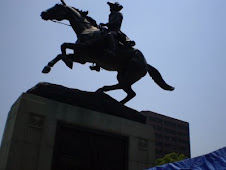Bessie Coleman, aviation pioneer
Every Memorial Day, black men and women aviators fly in formation over the grave of Bessie Coleman, dropping bouquests of flowers on the grave of the first black woman ever to earn a pilot's license.
Coleman was born in 1892, the twelfth of thirteen children. The family earned their living picking cotton. It was an impoverished existence, and as her siblings reached adulthood two of them left for Chicago, where opportunities were better.
Bessie Coleman followed when she grew up. She trained as a manicurist and got a job at the White Sox Barber Shop, situated on the Stroll,an 8-block section of State Street where black-owned businesses flourished. It was there that she encountered Robert S. Abbott, the editor of the Chicago Defender, a prominent newspaper read widely in the black community.
She developed a desire to become a pilot, inspired by stories of the derring-do of the Wolrd War I flying aces. This was an unthinkable ambition for a black woman at the time. Yet Abbott saw something of the potential in Bessie, and offered her financial help to attend a French flying school. He guessed that she would make great copy, and he was right. On her return from France with her pilot's license, she was greeted by representatives of both the black and white press.
Beautiful and flamboyant, she became an overnight sensation. Barnstorming and stunt flying were all the rage at the time, and no one's exploits were more daring than Coleman's. She became a hero to the black community, who dubbed her "Queen Bess." Her ambition was to start a flight school for black people, to encourage them to follow careers in the promising new field of aviation.
Her career was fraught with peril: many of the barnstorming stunts were daring and dangerous. Coleman also suffered from a lack of sufficient funds and therfore often relied on decrepit and unsafe planes. In California, on February 4, 1922, a plane she was piloting stalled at 300 feet, smashing into the ground. She suffered multiple injuries which landed her in the hospital for three months.
Undaunted, she relocated to Texas and resumed her barnstorming career. She had previously performed in the North, to appreciative white audiences. She now visited venues mainly in the South, where African Americans were her most enthusiastic fans. They opened their homes and hearts to her. Colemans' beauty, skill and daring inspired her African American fans.
According to her niece, "The airplanes she was flying, they were just old things....They weeren't worth a darn." The lack of adequate funds did not stop her, however, from planning a flight in Jacksonville, FL. in a ramshackle plane.
Coleman waas planning a parachute stunt, so she went up to scout the territory with her mechanic, William Wills, at the controls. Wills lost control of the plane, and Coleman, with neither seat belt nor parachute, was hurled to her death. She was 34 years old.
Her influence, however, lived on. Within a few years William Powell founded the Bessie Coleman Aero Club, both to honor her and to inspire other African Americans to follow her example. Her dream lived on, and still lives on to this day.











1 comment:
This was really interesting. I spent the entire month of February on various Black History topics and political banter. Thanks.
Post a Comment